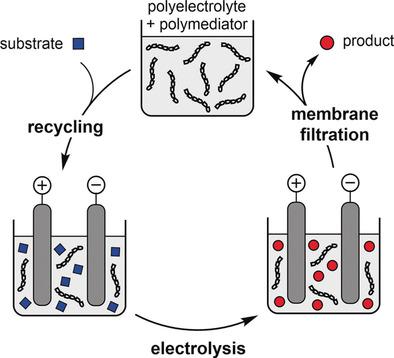当前位置:
X-MOL 学术
›
Angew. Chem. Int. Ed.
›
论文详情
Our official English website, www.x-mol.net, welcomes your
feedback! (Note: you will need to create a separate account there.)
On the Use of Polyelectrolytes and Polymediators in Organic Electrosynthesis
Angewandte Chemie International Edition ( IF 16.1 ) Pub Date : 2017-12-12 , DOI: 10.1002/anie.201710659 Benjamin Schille 1 , Niels Ole Giltzau 1 , Robert Francke 1
Angewandte Chemie International Edition ( IF 16.1 ) Pub Date : 2017-12-12 , DOI: 10.1002/anie.201710659 Benjamin Schille 1 , Niels Ole Giltzau 1 , Robert Francke 1
Affiliation

|
Although organic electrosynthesis is generally considered to be a green method, the necessity for excess amounts of supporting electrolyte constitutes a severe drawback. Furthermore, the employment of redox mediators results in an additional separation problem. In this context, we have explored the applicability of soluble polyelectrolytes and polymediators with the TEMPO‐mediated transformation of alcohols into carbonyl compounds as a test reaction. Catalyst benchmarking based on cyclic voltammetry studies indicated that the redox‐active polymer can compete with molecularly defined TEMPO species. Alcohol oxidation was also highly efficient on a preparative scale, and our polymer‐based approach allowed for the separation of both mediator and supporting electrolyte in a single membrane filtration step. Moreover, we have shown that both components can be reused multiple times.
中文翻译:

聚电解质和介体在有机电合成中的应用
尽管通常认为有机电合成是一种绿色方法,但是过量支持电解质的必要构成了严重的缺点。此外,使用氧化还原介体导致另外的分离问题。在这种情况下,我们已经探索了将可溶性聚电解质和聚介体与TEMPO介导的醇转化为羰基化合物作为测试反应的适用性。基于循环伏安法研究的催化剂基准测试表明,氧化还原活性聚合物可以与分子定义的TEMPO种类竞争。酒精氧化在制备规模上也非常高效,我们基于聚合物的方法允许在单个膜过滤步骤中分离介体和支持电解质。而且,
更新日期:2017-12-12
中文翻译:

聚电解质和介体在有机电合成中的应用
尽管通常认为有机电合成是一种绿色方法,但是过量支持电解质的必要构成了严重的缺点。此外,使用氧化还原介体导致另外的分离问题。在这种情况下,我们已经探索了将可溶性聚电解质和聚介体与TEMPO介导的醇转化为羰基化合物作为测试反应的适用性。基于循环伏安法研究的催化剂基准测试表明,氧化还原活性聚合物可以与分子定义的TEMPO种类竞争。酒精氧化在制备规模上也非常高效,我们基于聚合物的方法允许在单个膜过滤步骤中分离介体和支持电解质。而且,





















































 京公网安备 11010802027423号
京公网安备 11010802027423号